四年级下册英语全套教案-全册∣鲁科版(五四制)(三起)
- 格式:pdf
- 大小:14.71 KB
- 文档页数:10
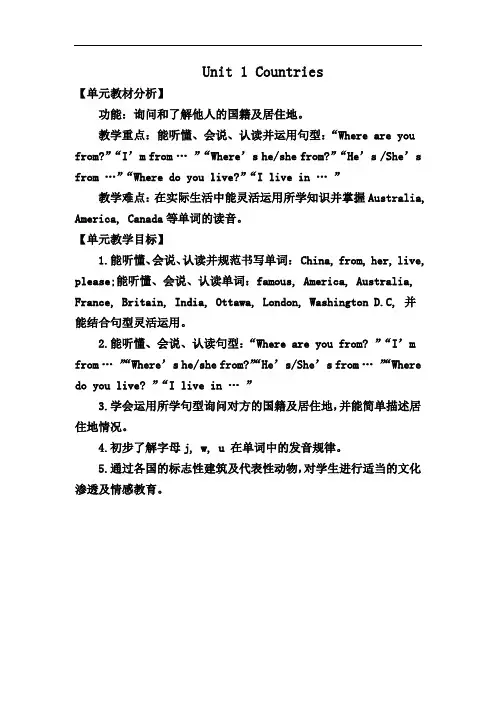
Unit 1 Countries【单元教材分析】功能:询问和了解他人的国籍及居住地。
教学重点:能听懂、会说、认读并运用句型:“Where are you from?”“I’m from …”“Where’s he/she from?”“He’s /She’s from …”“Where do you live?”“I live in …”教学难点:在实际生活中能灵活运用所学知识并掌握Australia, America, Canada等单词的读音。
【单元教学目标】1.能听懂、会说、认读并规范书写单词: China, from, her, live, please;能听懂、会说、认读单词:famous, America, Australia, France, Britain, India, Ottawa, London, Washington D.C, 并能结合句型灵活运用。
2.能听懂、会说、认读句型:“Where are you from? ”“I’m from …”“Where’s he/she from?”“He’s/She’s from …”“Where do you live? ”“I live in …”3.学会运用所学句型询问对方的国籍及居住地,并能简单描述居住地情况。
4.初步了解字母j, w, u 在单词中的发音规律。
5.通过各国的标志性建筑及代表性动物,对学生进行适当的文化渗透及情感教育。
Lesson1 I’m from Britain.课型:新授课一、教学目标:1.能听懂、会说、认读单词:China, from, Canada, America, Britain.2.能听懂、会说、认读并运用句型:“Where are you from?”“I’m from…”3.学会运用所学句型询问对方的国籍。
二、教学重难点:重点:能听懂、会说、认读并灵活运用句型:“Where are you from?”“I’m from…”.难点:单词America,Canada,Britain的发音及运用。
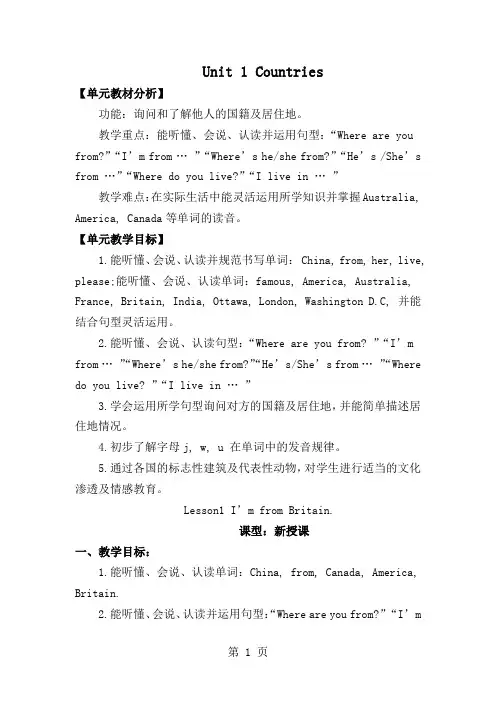
Unit 1 Countries【单元教材分析】功能:询问和了解他人的国籍及居住地。
教学重点:能听懂、会说、认读并运用句型:“Where are you from?”“I’m from …”“Where’s he/she from?”“He’s /She’s from …”“Where do you live?”“I live in …”教学难点:在实际生活中能灵活运用所学知识并掌握Australia, America, Canada等单词的读音。
【单元教学目标】1.能听懂、会说、认读并规范书写单词: China, from, her, live, please;能听懂、会说、认读单词:famous, America, Australia, France, Britain, India, Ottawa, London, Washington D.C, 并能结合句型灵活运用。
2.能听懂、会说、认读句型:“Where are you from? ”“I’m from …”“Where’s he/she from?”“He’s/She’s from …”“Where do you live? ”“I live in …”3.学会运用所学句型询问对方的国籍及居住地,并能简单描述居住地情况。
4.初步了解字母j, w, u 在单词中的发音规律。
5.通过各国的标志性建筑及代表性动物,对学生进行适当的文化渗透及情感教育。
Lesson1 I’m from Britain.课型:新授课一、教学目标:1.能听懂、会说、认读单词:China, from, Canada, America, Britain.2.能听懂、会说、认读并运用句型:“Where are you from?”“I’mfrom…”3.学会运用所学句型询问对方的国籍。
二、教学重难点:重点:能听懂、会说、认读并灵活运用句型:“Where are you from?”“I’m from…”.难点:单词America,Canada,Britain的发音及运用。
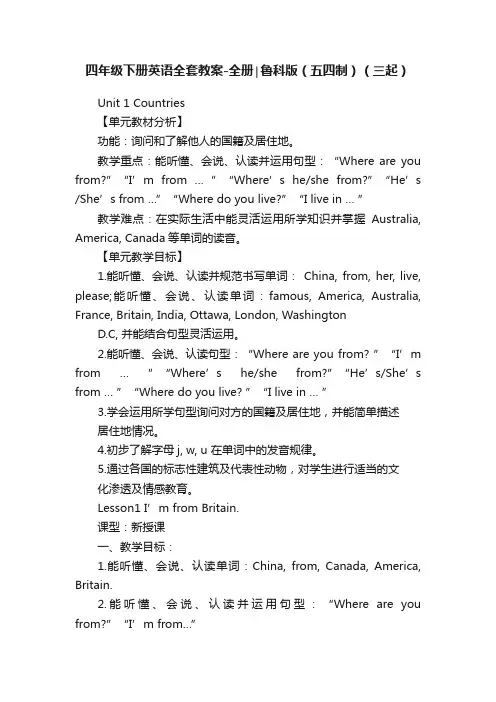
四年级下册英语全套教案-全册∣鲁科版(五四制)(三起)Unit 1 Countries【单元教材分析】功能:询问和了解他人的国籍及居住地。
教学重点:能听懂、会说、认读并运用句型:“Where are you from?”“I’m from … ”“Where’s he/she from?”“He’s /She’s from …”“Where do you live?”“I live in … ”教学难点:在实际生活中能灵活运用所学知识并掌握Australia, America, Canada等单词的读音。
【单元教学目标】1.能听懂、会说、认读并规范书写单词:China, from, her, live, please;能听懂、会说、认读单词:famous, America, Australia, France, Britain, India, Ottawa, London, WashingtonD.C, 并能结合句型灵活运用。
2.能听懂、会说、认读句型:“Where are you from? ”“I’m from … ”“Where’s he/she from?”“He’s/She’s from … ”“Where do you live? ”“I live in … ”3.学会运用所学句型询问对方的国籍及居住地,并能简单描述居住地情况。
4.初步了解字母j, w, u 在单词中的发音规律。
5.通过各国的标志性建筑及代表性动物,对学生进行适当的文化渗透及情感教育。
Lesson1 I’m from Britain.课型:新授课一、教学目标:1.能听懂、会说、认读单词:China, from, Canada, America, Britain.2.能听懂、会说、认读并运用句型:“Where are you from?”“I’m from…”3.学会运用所学句型询问对方的国籍。
二、教学重难点:重点:能听懂、会说、认读并灵活运用句型:“Where are you from?”“I’m from…”.难点:单词America,Canada,Britain的发音及运用。
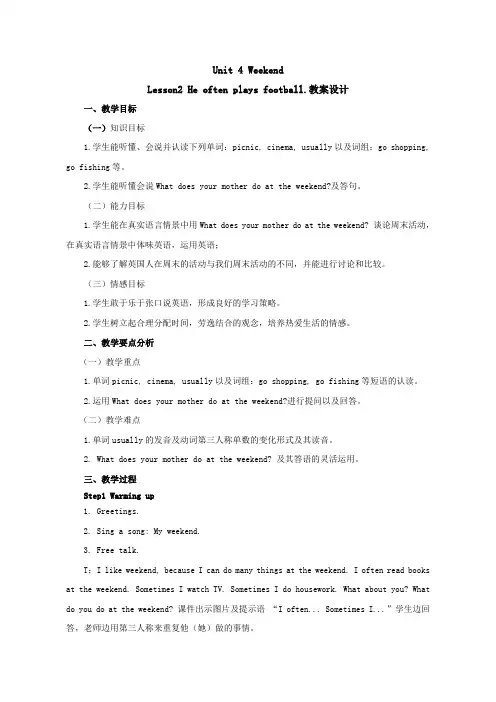
Unit 4 WeekendLesson2 He often plays football.教案设计一、教学目标(一)知识目标1.学生能听懂、会说并认读下列单词:picnic, cinema, usually以及词组:go shopping, go fishing等。
2.学生能听懂会说What does your mother do at the weekend?及答句。
(二)能力目标1.学生能在真实语言情景中用What does your mother do at the weekend? 谈论周末活动,在真实语言情景中体味英语,运用英语;2.能够了解英国人在周末的活动与我们周末活动的不同,并能进行讨论和比较。
(三)情感目标1.学生敢于乐于张口说英语,形成良好的学习策略。
2.学生树立起合理分配时间,劳逸结合的观念,培养热爱生活的情感。
二、教学要点分析(一)教学重点1.单词picnic, cinema, usually以及词组:go shopping, go fishing等短语的认读。
2.运用What does your mother do at the weekend?进行提问以及回答。
(二)教学难点1.单词usually的发音及动词第三人称单数的变化形式及其读音。
2. What does your mother do at the weekend? 及其答语的灵活运用。
三、教学过程Step1 Warming up1. Greetings.2. Sing a song: My weekend.3. Free talk.T:I like weekend, because I can do many things at the weekend. I often read books at the weekend. Sometimes I watch TV. Sometimes I do housework. What about you? What do you do at the weekend? 课件出示图片及提示语“I often... Sometimes I...”学生边回答,老师边用第三人称来重复他(她)做的事情。
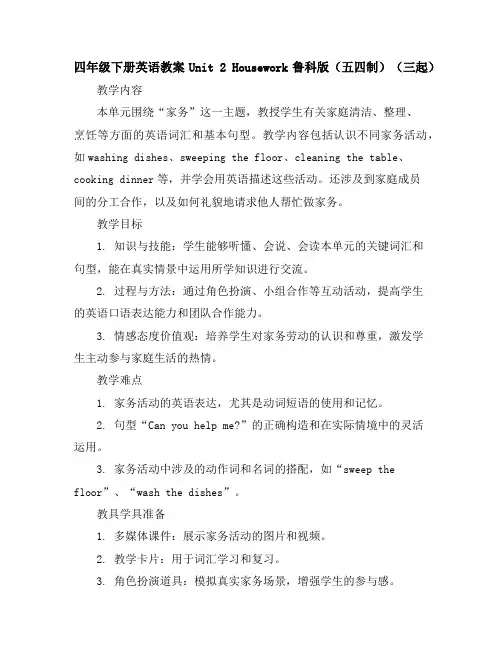
四年级下册英语教案Unit 2 Housework鲁科版(五四制)(三起)教学内容本单元围绕“家务”这一主题,教授学生有关家庭清洁、整理、烹饪等方面的英语词汇和基本句型。
教学内容包括认识不同家务活动,如washing dishes、sweeping the floor、cleaning the table、cooking dinner等,并学会用英语描述这些活动。
还涉及到家庭成员间的分工合作,以及如何礼貌地请求他人帮忙做家务。
教学目标1. 知识与技能:学生能够听懂、会说、会读本单元的关键词汇和句型,能在真实情景中运用所学知识进行交流。
2. 过程与方法:通过角色扮演、小组合作等互动活动,提高学生的英语口语表达能力和团队合作能力。
3. 情感态度价值观:培养学生对家务劳动的认识和尊重,激发学生主动参与家庭生活的热情。
教学难点1. 家务活动的英语表达,尤其是动词短语的使用和记忆。
2. 句型“Can you help me?”的正确构造和在实际情境中的灵活运用。
3. 家务活动中涉及的动作词和名词的搭配,如“sweep the floor”、“wash the dishes”。
教具学具准备1. 多媒体课件:展示家务活动的图片和视频。
2. 教学卡片:用于词汇学习和复习。
3. 角色扮演道具:模拟真实家务场景,增强学生的参与感。
4. 黑板和粉笔:用于板书设计和展示重点知识。
教学过程1. 导入:通过播放一段关于家庭日常家务的视频,吸引学生的注意力,并引出本课主题。
2. 新授:利用教学卡片,分步骤教授本课的生词和句型,配合图片和动作,加深学生的理解和记忆。
3. 实践:组织学生进行角色扮演,模拟家庭中做家务的情景,鼓励学生用英语进行交流。
4. 巩固:通过小组竞赛,让学生运用所学知识完成任务,教师提供实时指导和反馈。
板书设计板书设计将简洁明了地展示本课的关键词汇、句型结构以及重点语法点。
通过颜色区分、图表辅助等方式,使板书内容层次分明,便于学生记录和复习。
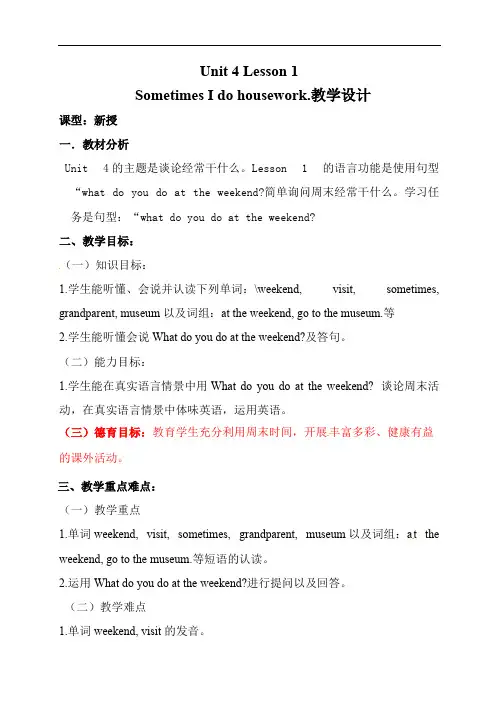
Unit 4 Lesson 1Sometimes I do housework.教学设计课型:新授一.教材分析Unit 4的主题是谈论经常干什么。
Lesson 1 的语言功能是使用句型“what do you do at the weekend?简单询问周末经常干什么。
学习任务是句型:“what do you do at the weekend?二、教学目标:(一)知识目标:1.学生能听懂、会说并认读下列单词:\weekend, visit, sometimes, grandparent, museum以及词组:at the weekend, go to the museum.等2.学生能听懂会说What do you do at the weekend?及答句。
(二)能力目标:1.学生能在真实语言情景中用What do you do at the weekend? 谈论周末活动,在真实语言情景中体味英语,运用英语。
(三)德育目标:教育学生充分利用周末时间,开展丰富多彩、健康有益的课外活动。
三、教学重点难点:(一)教学重点1.单词weekend, visit, sometimes, grandparent, museum以及词组:at the weekend, go to the museum.等短语的认读。
2.运用What do you do at the weekend?进行提问以及回答。
(二)教学难点1.单词weekend, visit的发音。
2. What do you do at the weekend? 及其答语的灵活运用。
四、教具准备:教学光盘、单词卡片、录音机、调查表、记者证、有关活动的图片。
五、教学方法:情景教学法,活动教学法,合作教学法六、教学过程:Activity 1 Organization1. Greetings.2.学生随音乐唱歌曲“Days of the week”。
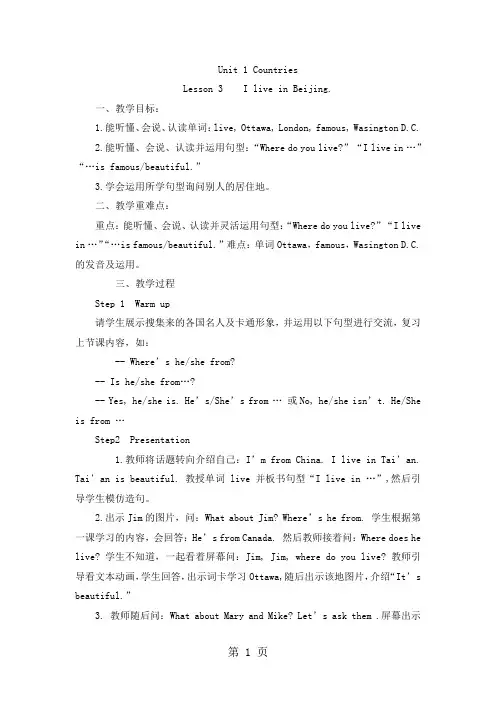
Unit 1 CountriesLesson 3 I live in Beijing.一、教学目标:1.能听懂、会说、认读单词:live, Ottawa, London, famous, Wasington D.C.2.能听懂、会说、认读并运用句型:“Where do you live?”“I live in …”“…is famous/beautiful.”3.学会运用所学句型询问别人的居住地。
二、教学重难点:重点:能听懂、会说、认读并灵活运用句型:“Where do you live?”“I live in …”“…is famous/beautiful.”难点:单词Ottawa,famous,Wasington D.C.的发音及运用。
三、教学过程Step 1 Warm up请学生展示搜集来的各国名人及卡通形象,并运用以下句型进行交流,复习上节课内容,如:-- Where’s he/she from?-- Is he/she from…?-- Yes, he/she is. He’s/She’s from …或No, he/she isn’t. He/She is from …Step2 Presentation1.教师将话题转向介绍自己:I’m from China. I live in Tai’an. Tai’an is beautiful. 教授单词live 并板书句型“I live in …”,然后引导学生模仿造句。
2.出示Jim的图片,问:What about Jim? Where’s he from. 学生根据第一课学习的内容,会回答:He’s from Canada. 然后教师接着问:Where does he live? 学生不知道,一起看着屏幕问:Jim, Jim, where do you live? 教师引导看文本动画,学生回答,出示词卡学习Ottawa,随后出示该地图片,介绍“It’s beautiful.”3. 教师随后问:What about Mary and Mike? Let’s ask them .屏幕出示人物图片,师生共问:Mary, Mary, where do you live? Mike, Mike, where do you live? 观看文本动画,连线,学习新词London, Washington D.C. 同时出示一些该地风光图片,并介绍:It’s famous.4. Listen and imitate.5.Read the text by themselves.6.Act.Step 3 Practice1.Let’s talk出示第一幅图,请一名学生戴上头饰,另一名学生与其进行问答,教师给予适当帮助,做示范。
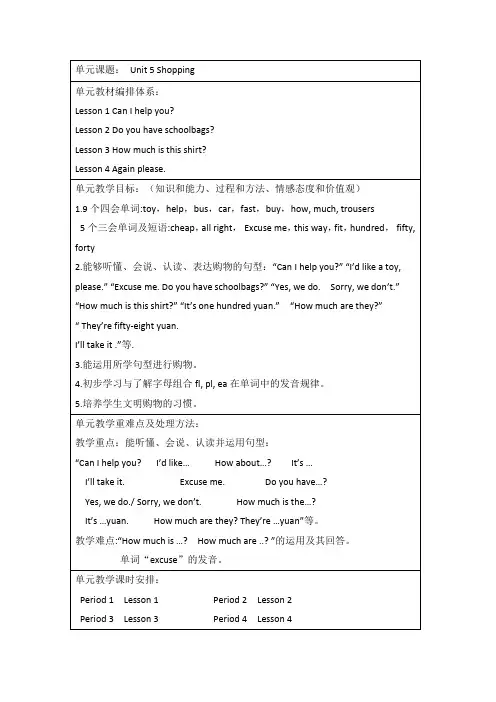

子们还是有了较多的了解了,所以教师应该激活孩子们的思维,让英语课堂更贴近学生生活,更富童趣。
mother do
谈论周末活动,在真实语言情景中体味英语,运用英语;
以及词组:go
Read after me
Chant:
I go swimming at the weekend. What do
What do y ou do at the weekend
loo k.
go es
四人一组拿出上节课布置的调查表。
用
等句型互相问答练习。
最后小组展示。
Activity 3 Summary
师生齐读黑板板书的重点句子。
找学生回答今天都学到了什么?老师强调
个好朋友的周末活动安排。
下节课交流
“Fre e
kite…”
weekend?并引导学生在情景中进行学习活动,用活泼多样的教学活动代替机械操练,把游戏、唱歌、等以及个人活动,小组活动带
用周末时间,培养良好的兴趣爱好,开展有益于身心健康的活动,并让学生在体验中学习课外知识,从而身心得到健康发展。
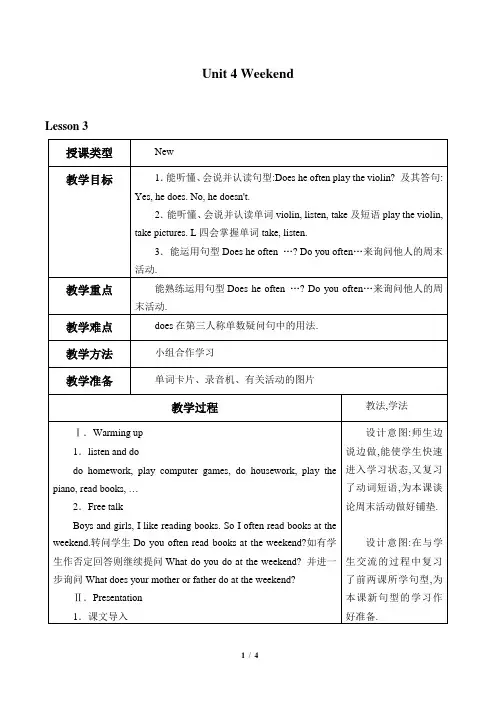
Unit 4 WeekendWe all enjoy our weekend. Look, (出示课件)Jenny and Miss Zhang are talking about weekend .What does Jenny do at the weekend? 让学生自己读第一幅图并回答: She often takes pictures.教师用肢体语言让学生理解take pictures 的意思,板书并学说短语, 区分draw pictures 与take pictures.2.出示Tom 打电脑的图片,并问What's Tom doing? 学生会根据已有知识作答: He's playing computer games. 教师继而引出本课句型: Does he often play computer games? 板书并领读,之后让学生们猜一猜.大部分学生受图片的影响会做出肯定回答.教师播放光盘,让学生整体感知课文,并回答问题.师板书答句: No, he doesn't. 教师补充:Tom is a good boy. He doesn't often play computer games. He often writes emails on the computer.3.出示Peter 拉小提琴的图片,师指着小提琴学说violin, 做动作学说短语play the violin. T: I can't play the violin. 提问同学们Can you play the violin? 对作肯定回答的同学说:Do you often play the violin at the weekend? 然后把话题引回:Does Peter often play the violin at the weekend? 第二次播放光盘,并回答问题.师板书答句: Yes, he does. Peter often plays the violin, so he can play the violin very well.设计意图:针对课文四幅图分别介绍了四个人物周末活动的特点,我根据内容的难易分别通过读一读,听一听,猜一猜等几种不同的方法使学生了解他们的周末活动,并适时引出重点句型Does he often play the piano?Yes, he does. No, hedoesn't.4.What does Guo Yang do at the weekend? Please read the fourth picture and find the answer. 让学生读第四幅图并找学生回答问题:He often plays the piano, sometimes he listens to music.5.listen and repeat.6.同位分角色朗读.Ⅲ.Practice.1.Chant.Take pictures, take pictures, Does Jenny often take pictures? Yes, she does, Yes, she does, She often takes pictures at the weekend.Play the piano, play the piano, Does Tom often play the piano? No, he doesn't. No, he doesn't. He often plays the violin at the weekend.(通过chant来巩固重点句型和短语,加深记忆.)2.Let's talk.Peter often plays the violin at the weekend.What else does he often do? 他周末还做些什么呢? Let's have a look.。
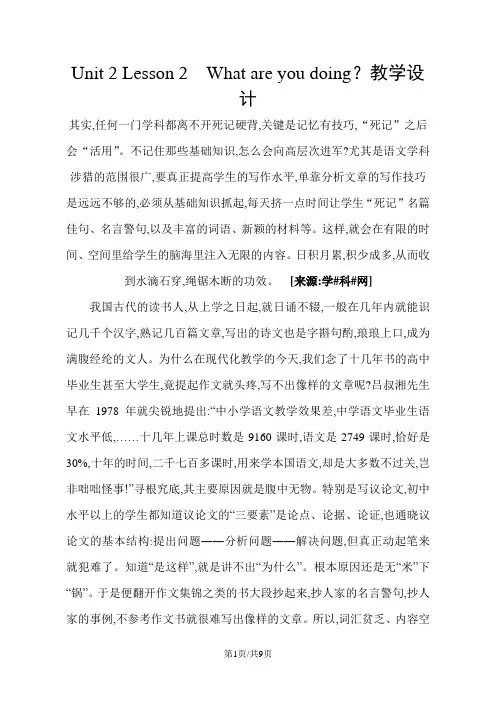
Unit 2 Lesson 2 What are you doing?教学设计其实,任何一门学科都离不开死记硬背,关键是记忆有技巧,“死记”之后会“活用”。
不记住那些基础知识,怎么会向高层次进军?尤其是语文学科涉猎的范围很广,要真正提高学生的写作水平,单靠分析文章的写作技巧是远远不够的,必须从基础知识抓起,每天挤一点时间让学生“死记”名篇佳句、名言警句,以及丰富的词语、新颖的材料等。
这样,就会在有限的时间、空间里给学生的脑海里注入无限的内容。
日积月累,积少成多,从而收到水滴石穿,绳锯木断的功效。
[来源:学#科#网]我国古代的读书人,从上学之日起,就日诵不辍,一般在几年内就能识记几千个汉字,熟记几百篇文章,写出的诗文也是字斟句酌,琅琅上口,成为满腹经纶的文人。
为什么在现代化教学的今天,我们念了十几年书的高中毕业生甚至大学生,竟提起作文就头疼,写不出像样的文章呢?吕叔湘先生早在1978年就尖锐地提出:“中小学语文教学效果差,中学语文毕业生语文水平低,……十几年上课总时数是9160课时,语文是2749课时,恰好是30%,十年的时间,二千七百多课时,用来学本国语文,却是大多数不过关,岂非咄咄怪事!”寻根究底,其主要原因就是腹中无物。
特别是写议论文,初中水平以上的学生都知道议论文的“三要素”是论点、论据、论证,也通晓议论文的基本结构:提出问题――分析问题――解决问题,但真正动起笔来就犯难了。
知道“是这样”,就是讲不出“为什么”。
根本原因还是无“米”下“锅”。
于是便翻开作文集锦之类的书大段抄起来,抄人家的名言警句,抄人家的事例,不参考作文书就很难写出像样的文章。
所以,词汇贫乏、内容空洞、千篇一律便成了中学生作文的通病。
要解决这个问题,不能单在布局谋篇等写作技方面下功夫,必须认识到“死记硬背”的重要性,让学生积累足够的“米”。
一、课型:新授课单靠“死”记还不行,还得“活”用,姑且称之为“先死后活”吧。
让学生把一周看到或听到的新鲜事记下来,摒弃那些假话套话空话,写出自己的真情实感,篇幅可长可短,并要求运用积累的成语、名言警句等,定期检查点评,选择优秀篇目在班里朗读或展出。
四年级下册英语教案Unit 2 Lesson 1 Can you clean the windows 鲁科版五四制教学内容本课是鲁科版五四制四年级下册英语Unit 2的第一课,主要教学内容为情态动词“can”的用法,以及与家务劳动相关的动词短语。
通过本课的学习,学生将能够理解并运用“Can you?”的句型,询问和回答是否能做某事。
教学目标1. 学生能够理解并正确使用情态动词“can”。
2. 学生能够听懂、会说、会读本课所学的动词短语,如“clean the windows”,“sweep the floor”等。
3. 学生能够运用“Can you?”的句型,询问并回答是否能做某事。
4. 学生能够通过本课的学习,培养做家务的意识和习惯。
教学难点1. 情态动词“can”的用法。
2. 动词短语的听说读写。
3. “Can you?”句型的运用。
教具学具准备1. 多媒体教学设备。
2. 本课单词卡片。
3. 家务劳动图片。
教学过程1. 导入利用图片或实物,引导学生复习上一单元的内容,为新课的学习做好铺垫。
2. 新课内容展示利用多媒体教学设备,展示本课的单词和句型,让学生跟读并模仿。
3. 互动练习设计一些小游戏,让学生在游戏中练习本课的单词和句型,如“猜猜我能做什么”等。
4. 角色扮演让学生分组进行角色扮演,模拟真实场景,运用本课所学知识进行交流。
板书设计1. Unit 2 Lesson 1 Can you clean the windows2. 主要内容:情态动词“can”的用法,家务劳动动词短语,句型“Can you?”3. 关键词:can, clean the windows, sweep the floor, etc.作业设计1. 完成课后练习题。
2. 跟读课文录音,模仿语音语调。
3. 用“Can you?”的句型,询问并回答家人的家务劳动情况。
课后反思本课结束后,教师应认真反思教学效果,针对学生的掌握情况,及时调整教学方法和策略,以提高学生的学习效果。
Unit 4 Lesson 1 It’s spring.教学设计孙海燕一、教学目标设计(一)知识目标1.掌握新单词:season,year,spring,summer,autumn,winter.2.能用“What season is it ?”来询问季节,用“It’s spring/summer...”来回答季节情况;能用“I like spring/summer... ”描述对季节的喜好。
(二)能力目标1.能够运用所学单词询问和回答四个季节。
2. 培养学生通过观察图画,感受大自然,表述自己的感受的能力;培养学生听、说、读、及灵活运用语言的能力(三)情感态度目标1、能在课堂活动中获得积极的情感体验,大胆主动地与人交流,展示自我。
使学生能在一定的语境中学会使用已学过的英语进行交流。
2、进一步培养学生学习英语的兴趣,在语言教学中激发学生热爱生活、热爱大自然的美好情操,培养积极乐观的生活情感态度。
二、教具准备课件、录音机、录音带、单词卡片.三、教学重点1、能听懂、会说、认读和规范书写单词season,year,spring,summer,autumn,winter。
2、能听懂、会说、会读日常交际用语: “What season is it?” “It’s spring/summer/…”四、教学难点:1、能掌握四个表示季节的单词,能正确表达季节。
2、能听懂、会说、会读句子,并能正确、熟练地运用。
五、教学过程设计Step One: Warming-up1、Greetings. Good morning,boys and girls. How are you ? What day is today? The first ,let’s sing a song ----“Days of the week”2、Leading in:T:The song is about days of week ,right? And we have 7 days in a week,yes ?Do you know how many seasons in a year ?T:This class,we’ll talk about Unit 4 seasons.Step two:Presentation and practice1、(出示单词卡“season”“year”)T: Now ,who can tell me,how many seasons do we have in a year?S: Four season.T:Year! (教师引导学生回答)We have four seasons in a year. Now ,look at the picture .What season is it? What season is it? It’s spring.教授单词spring3、展示有关季节的画面,引出新单词:T: What season is it now?Yeah!Summer. Do you know summer? It’s the second season in a year.In summer,the trees are green,and the flowers are colorful.In the third season,the trees turn yellow,the leaves start to fall. What season is it? It’s autumn.(单词卡)Look at the picture,the trees are white,and it starts to snow. What season is it? It’s winter.(单词卡)2、利用图片做游戏:猜猜看What season is it? 练习句型:It’s spring/summer/autumn/winter.3、鼓励学生模仿老师自编儿歌。
Unit 1 Countries【单元教材分析】功能:询问和了解他人的国籍及居住地。
教学重点:能听懂、会说、认读并运用句型:“Where are you from?”“I’m from … ”“Where’s he/she from?”“He’s /She’s from …”“Where do you live?”“I live in …”教学难点:在实际生活中能灵活运用所学知识并掌握Australia, America, Canada等单词的读音。
【单元教学目标】1.能听懂、会说、认读并规范书写单词: China, from, her, live, please;能听懂、会说、认读单词:famous, America, Australia, France, Britain, India, Ottawa, London, WashingtonD.C, 并能结合句型灵活运用。
2.能听懂、会说、认读句型:“Where are you from? ”“I’m from …”“Where’s he/she from?”“He’s/She’s from …”“Where do you live? ”“I live in …”3.学会运用所学句型询问对方的国籍及居住地,并能简单描述居住地情况。
4.初步了解字母j, w, u 在单词中的发音规律。
5.通过各国的标志性建筑及代表性动物,对学生进行适当的文化渗透及情感教育。
Lesson1 I’m from Britain.课型:新授课一、教学目标:1.能听懂、会说、认读单词:China, from, Canada, America, Britain.2.能听懂、会说、认读并运用句型:“Where are you from?”“I’m from…”3.学会运用所学句型询问对方的国籍。
二、教学重难点:重点:能听懂、会说、认读并灵活运用句型:“Where are you from?”“I’m from…”.难点:单词America,Canada,Britain的发音及运用。
三、教学过程Step 1 Warm up1. Greetings.Hello, everyone!2. Free talk.How are you today?Did you have a good time for your holidays?Where did you go?(找几个学生起来说一说假期去了哪些地方,为下面做铺垫。
)这时在大屏幕上显示“Where d id you go?I went to… ”引导学生用此句型回答。
Step 2 Presentation1. T: Look, this is our old friend Li Ming.T: Now I’m Li Ming.(老师带上头饰)I’m f rom China.(板书句子“I’m from China.”)China is our country.Show the word card and read the word together.“China”the letter “i”is pronounced / ai /.“from” the letter“o”is pronounced/?/.Girls read together. Boys read together.2. T: OK, class. I’m f rom China.Where are you from?(板书)Then let Ss use “I’m from China.”to answer.3. Read the new sentences together.4. T: In this class, I’ll introduce some new friends to you.Watch the CD-Rom,let’s see “Who comes to China?”Check the answers: Jim,Mike,Danny,Mary.5. Let’s listen to the tape again,and find out the answers.(1)If you are Jim ,where are you from?(2)If you are Mike,where are you from?(3)If you are Mary,where are you from?6. Then check the answers and teach the new words:Canada,America,Britain.7. Read the new words together.8. Listen and imitate.9. Read the text in groups.Step 3 Practice1.Play a game: Sharp eyes.Show four pictures of Activity 2.T: Where are you from?S: I’m from…2.Sing a song:《Where are you from》两只老虎的曲调Where are you from? Where are you from?I’m from China. I’m from China.Where are you from? Where are you from?I’m from Canada. I’m from Canada.1)T sings. 2) Ss sing. 3)学生小组内根据歌曲自编。
3.Let’s do.提前给学生每人发一张代表国家的小卡片。
Make a dialogue in groups.——Hello!——Hello! What’s your name?——I’m …——Where are you from?——I’m from …Step 4 SummaryT:What have you learnt in this class?Then read the new words and sentences together.Step5 HomeworkListen to the tape and repeat it 3 times.Lesson 2 Where’s she from?课型:新授课一、教学目标:1.能听懂、会说、认读单词:Australia, India, France.2.能听懂、会说、认读并运用句型:“Where’s he/she from?”“He’s/She’s from…”“Is he/she from?”“Yes, he/she is.”3.学会运用所学句型询问别人的国籍。
二、教学重难点:重点:能听懂、会说、认读并灵活运用句型:“Where’she/she from?”“He’s/She’s from…”“Is he/she from?”“Yes, he/she is.”难点:单词Australia, India, France.的发音及运用。
三、教学过程Step 1 Warm up复习上节课所做的Let’s do活动,提前给学生每人发一张代表国家的小卡片。
Make a dialogue in groups.——Hello!——Hello! What’s your name?——I’m …——Where are you from?——I’m from …Step2 Presentation1.学习新句型:She’s/He’s from … 做完上面的对话练习后,屏幕出示上节课已学Let’s talk中的四幅图,同时出示四个国家对应的人物Jim, Li Ming, Mike,Mary. 教师介绍:Now we know Li Ming is from … 引导学生回答China. 教师接着说:Look, this is Jim. And we know he’s fom … 学生顺势回答Canada, 教师板书句型:He’s from … 并引导学生介绍剩余两张图片,在运用旧知的基础上运用了新句型。
2.进入文本,学习新句型:Where’s he from? 新单词:Australia.教师接着出示P6页第一幅图,介绍:Look! They’re our new friends. And that’s Sam. Can you guess “Where’s he from?”屏幕出示句子“Where’s he from?”,引导学生运用句型“He’s from … ”进行猜测。
随后教师说:Now l et’s check who’s right. 引导学生看课文动画并得到正确答案“He’s from Australia. ”学习新单词Australia.操练:— Where’s he from?— He’s from Australia.3.再次学习文本,连线,巩固新句型同时,学习新单词:India, Britain.What about our other friends? 相继出示两位女生图片,并问:Where’s she from? 看动画连线,运用新句型同时学习新单词:India, Britain.4.浏览文本,回答第三幅图问题,学习新句型“Is hefrom …?”“Yes, he is. /No, he isn’t.”同时学习新单词France.屏幕出示第三幅男孩图片,教师问:Is he from China? 学生自然会回答:No, he isn’t. 教师接着问:Is he from America? 学生回答不一,教师引导学生自己从文中找到答案,学生就找到了:No, he isn’t. He’s from France. 教师对会读的同学给予表扬,同时出示词卡France, 并教读。
5.Listen and imitate.6.Read the text by themselves.7.Act.Step 3 Practice1. Let’s talk.教师出示P7四幅图片,相继介绍,接着出示四个国家的人物,并让生运用句型问答— Where’s he/she from?— He’s from …2.Let’s do.教师安排四人小组提前准备已学国家的单词卡片,放到小盒内,一生抽取一张。
S2:Where are you from?S1: I’m from …S2:Where’s he/she from?S3,S4…:Is he/she from …S2: Yes, he/she is.No, he/she isn’t.Step 4 SummaryT:What have we learnt in this class?Then read the new words and sentences together.Step5 Homework1.Listen to the tape and imitate it 3 times.2.搜集各国名人或卡通人物,与同学交流,相互询问其国籍。